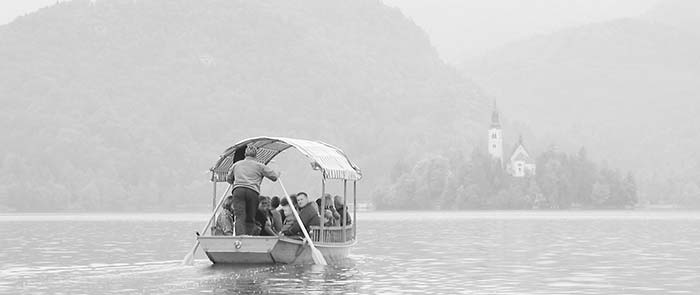
Lake Bled—Slovenia’s leading mountain resort—comes complete with a sweeping alpine panorama, a fairy-tale island, a cliff-hanging medieval castle, a lazy lakeside promenade, and the country’s most sought-after desserts. And the charms of its glorious mountain vistas and traditional folk life only crescendo as you explore the surrounding areas. Taken together, there are few more enjoyable places to simply be on vacation.
Since the Habsburg days, Lake Bled (locals pronounce it “blayd”) has been the place where Slovenes wow visiting diplomats. In the late 19th century, local aristocrats—who knew how to find a fine mountain resort—surrounded the humble lakefront village with classy villas. Tito also had one of his vacation homes here (today’s Hotel Vila Bled), where he entertained illustrious guests. But above all, Lake Bled feels like a place that Slovenes enjoy alongside their visitors.
Lake Bled has plenty of ways to idle away an afternoon. While the lake’s main town, also called Bled, is more functional than quaint, it offers postcard views of the lake and handy access to the region. Hike up to Bled Castle for intoxicating vistas. Make a wish and ring the bell at the island church. Wander or bike the dreamy path around the lake. Sit on a dock, dip your feet in the water, and feed some of the lake’s resident swans. Then dive into some of Bled’s famous cakes while you take in the view of Triglav, Slovenia’s favorite mountain (see the “Mount Triglav” sidebar on here). Bled quiets down at night—there’s no nightlife beyond a handful of pubs—giving hikers and other holiday-makers a chance to recharge.
Bled is also a great jumping-off point for a car trip through the Julian Alps (see next chapter), and a wide variety of other worthwhile side-trips are right at its doorstep. These include the less developed lake named Bohinj, even deeper in the mountains; a spectacular (yet easy) hike in the nearby mountain gorge of Vintgar; and the pleasant Old Town of Radovljica, with its fascinating little beekeeping museum.
Bled and its neighboring mountains deserve at least two days. With one day, spend it in and around Bled (or, spend a quick morning in Bled and an afternoon day-tripping). With a second day and a car, drive through the Julian Alps using the self-guided tour in the next chapter. The circular route takes you up and over the stunning Vršič Pass, then down the scenic and historic Soča River Valley. Without a car, skip the second day, or spend it doing nearby day trips: Bus or bike to Radovljica and its bee museum, hike to Vintgar Gorge, or visit Lake Bohinj (all described under “Near Lake Bled,” at the end of this chapter).
The town of Bled is on the east end of 1.5-mile-long Lake Bled. The lakefront is lined with soothing parks and chunky resort hotels. A 3.5-mile path meanders around the lake. As no motorized boats are allowed, Lake Bled is particularly peaceful.
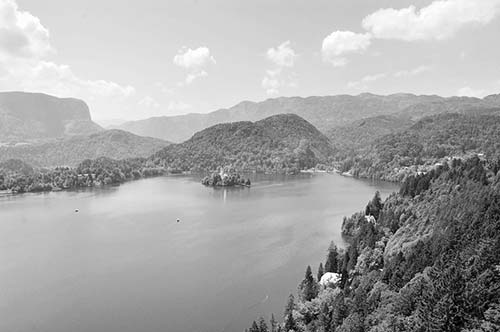
The tourists’ center of Bled has two parts, which melt into each other: a ragtag village and a cluster of giant hotels. The main thoroughfare, called Ljubljanska cesta, leads out of Bled town toward Ljubljana and most other destinations. Just up from the lakefront is the modern commercial center (Trgovski Center Bled), with a supermarket, ATM, shops, and a smattering of lively cafés. Nicknamed “Gaddafi,” the commercial center was designed for a city in Libya, but the deal fell through—so the frugal Slovenes built it here instead.
Bled’s less-touristy Old Town, under the castle, has a web of tight streets and big but humble old houses surrounding the pointy spire of St. Martin’s Church. Here you’ll find the bus station, some good restaurants, a few hostels, and more locals than tourists.
The mountains poking above the ridge at the far end of the lake are the Julian Alps, crowned by the three peaks of Mount Triglav. The big mountain behind the town of Bled is Stol (“Chair”), part of the Karavanke range that defines the Austrian border.
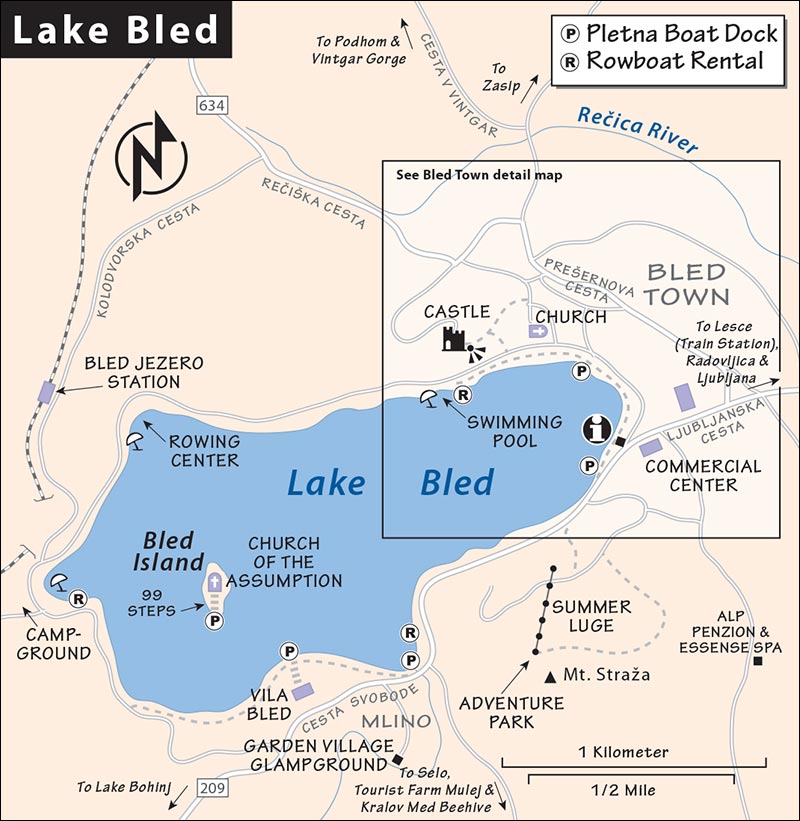
Bled’s most central TI is in the long, lakefront casino building across the street from the big, white Hotel Park (as you face the lake, the TI is hiding around the front at the far left end, overlooking the lake). Pick up the map with the lake on one side and the whole region on the other and the free Bled information booklet, with up-to-date details on local attractions and transportation options. Get advice on hikes and day trips, confirm transit schedules, and if you’re doing any serious hiking, spring for a good regional map. They also have free Wi-Fi and rent cars (July-Aug Mon-Sat 8:00-21:00, Sun 9:00-17:00; May-June and Sept-Oct Mon-Sat 8:00-19:00, Sun 11:00-17:00; Nov-April Mon-Sat 8:00-18:00, Sun 8:00-13:00; Cesta Svobode 10, tel. 04/574-1122, www.bled.si).
The TI’s other branch is harder to reach for nondrivers—on the main road out of town—but it conveniently shares an office with the Triglav National Park Information Center, which offers lots of helpful advice for those heading into the mountains. The center, with free parking, is called "Triglavska Roža" (free information, bike rentals, maps and guidebooks for sale; daily mid-April-mid-Oct 8:00-18:00; off-season until 16:00; Ljubljanska cesta 27, tel. 04/578-0205, www.tnp.si).
By Train: Two train stations have the name “Bled.” The Bled Jezero (“Bled Lake”) Station is across the lake from Bled town and is used only by infrequent, slow, tourist-oriented trains into the mountains. You’re much more likely to use the Lesce-Bled Station in the nearby village of Lesce (pronounced lest-SEH). The Lesce-Bled Station is on the main line and has far better connections to Ljubljana and international destinations. So if you’re buying a train ticket or checking schedules, request “Lesce-Bled” rather than just “Bled.” (This is so important, I’ll remind you again later.)
The small Lesce-Bled Station is in Lesce, about 2.5 miles from Bled. The nearest ATM is upstairs in the shopping center across the street (at the Gorenjska Banka on the third floor, across the parking lot from Mercator supermarket). From the station in Lesce, you can take the bus into Bled town (2/hour, 10 minutes, catch it across the street from the train station); or pay about €14 for a taxi into town. If taking the train out of Lesce-Bled, you can buy tickets at this station or on the train—nobody in Bled town sells tickets.
By Bus: Bled’s main bus station is just up from the lake in the Old Town. To reach the lake, walk straight downhill on Cesta Svobode. Note that many buses also stop on the way into town, along Ljubljanska cesta; it’s good to ask if your bus driver is willing to do so because it’s handier for walking to many of my recommended accommodations (for details, see “Sleeping in Bled,” later).
By Car: Coming from Ljubljana, you’ll wind your way into Bled on Ljubljanska cesta, which rumbles through the middle of town before swinging left at the lake. Parking is tricky; if you’re sleeping in town, ask your hotel. But if you’re only here for a quick visit (2-hour limit), you can try to find a spot in the short-term parking lot just above the commercial center (free for 1 hour; €2/2 hours), or along the lake (€2/hour). To stretch your visit, head for the underground lot between Hotel Krim and the ice rink (€2, 4-hour limit). If you’re staying even longer, park at the lot by the Triglav National Park Information Center and TI, on the road into town (described earlier; €5/24 hours). A new Mercator commercial center at the top of town, scheduled to open in 2017, may have unlimited parking—ask. Also see “Route Tips for Drivers” under “Lake Bled Connections” on here.
By Plane: For details on getting from Ljubljana’s airport to Bled, see “Lake Bled Connections,” later.
Exchange Rate: €1 = about $1.10
Country Calling Code: 386 (see here for dialing instructions).
Money: Bled town’s handiest ATMs are at SKB Banka (upstairs in round building at commercial center), Gorenjska Banka (at far end of Hotel Park), and NLB (on the main road into town, at Pension Union).
Post Office: It’s just above the commercial center on Ljubljanska cesta (Mon-Fri 8:00-19:00, Sat 8:00-12:00, closed Sun, July-Aug slightly longer, tel. 04/575-0200).
Laundry: Most hotels can do laundry for you, but it’s expensive (priced by the piece). You’ll get a better deal from a can-do local, Anže Štalc. Call Anže to arrange drop-off, and pick it up cleaned and folded 24 hours later (€15/load, €5 more for same-day express service, mobile 041-575-522).
Car Rental: The Julian Alps are ideal by car. Several companies have branches in Bled, including Europcar (mobile 031-382-055), Budget (mobile 041-578-0320), Sixt (mobile 030-645-350), Hertz (tel. 04/201-6999), and the local Avantcar (mobile 041-400-980); as the offices tend to move around, inquire in Bled about the current locations.
Massage: If you’re here to relax, consider a massage at the Essense wellness center at the recommended Alp Penzion. This modern, classy facility—hiding in the countryside about a 15-minute walk or 5-minute taxi ride above the lake—offers a wide range of spa treatments, including pedicures and Thai massage. A standard 50-minute massage will run you about €45 (call first to arrange, Cankarjeva cesta 20A, tel. 04/576-7450, www.essense.si, info@essense.si). You’ll also find wellness centers with massage, saunas, and whirlpools at a few of the newer big hotels, including the recommended Hotel Lovec, as well as Hotel Astoria and Golf Hotel (open to nonguests for an additional charge).
By Bike: You can rent a mountain bike at the TI (€3.50/hour, €6/3 hours, €8/half-day, €11/day). The TI also has electric bikes, which give you a much-appreciated boost once you get them moving (€5/1 hour, €10/4 hours, €15/8 hours). While walking around the lake is slo-mo bliss, biking it lets you fast-forward between the views of your choice. Biking is also a great way to reach Vintgar Gorge—about three mostly-level miles one-way, perfect for combining a countryside pedal with a walk immersed in nature. For a longer pedal, ask for the TI’s excellent biking map, with various great bike trips clearly marked and described. The separated bike path to the nearby town of Radovljica (and its bee museum) is about four level miles one-way (get details at the TI).
By Horse and Buggy: Buggies called fijakers are the romantic, expensive, and easy way to get around the lake. Hire one along the lakefront between Hotel Park and the castle (see map on here for location; around the lake-€40, one-way up to castle-€40, round-trip to castle with 30-minute wait time-€50, mobile 041-710-970).

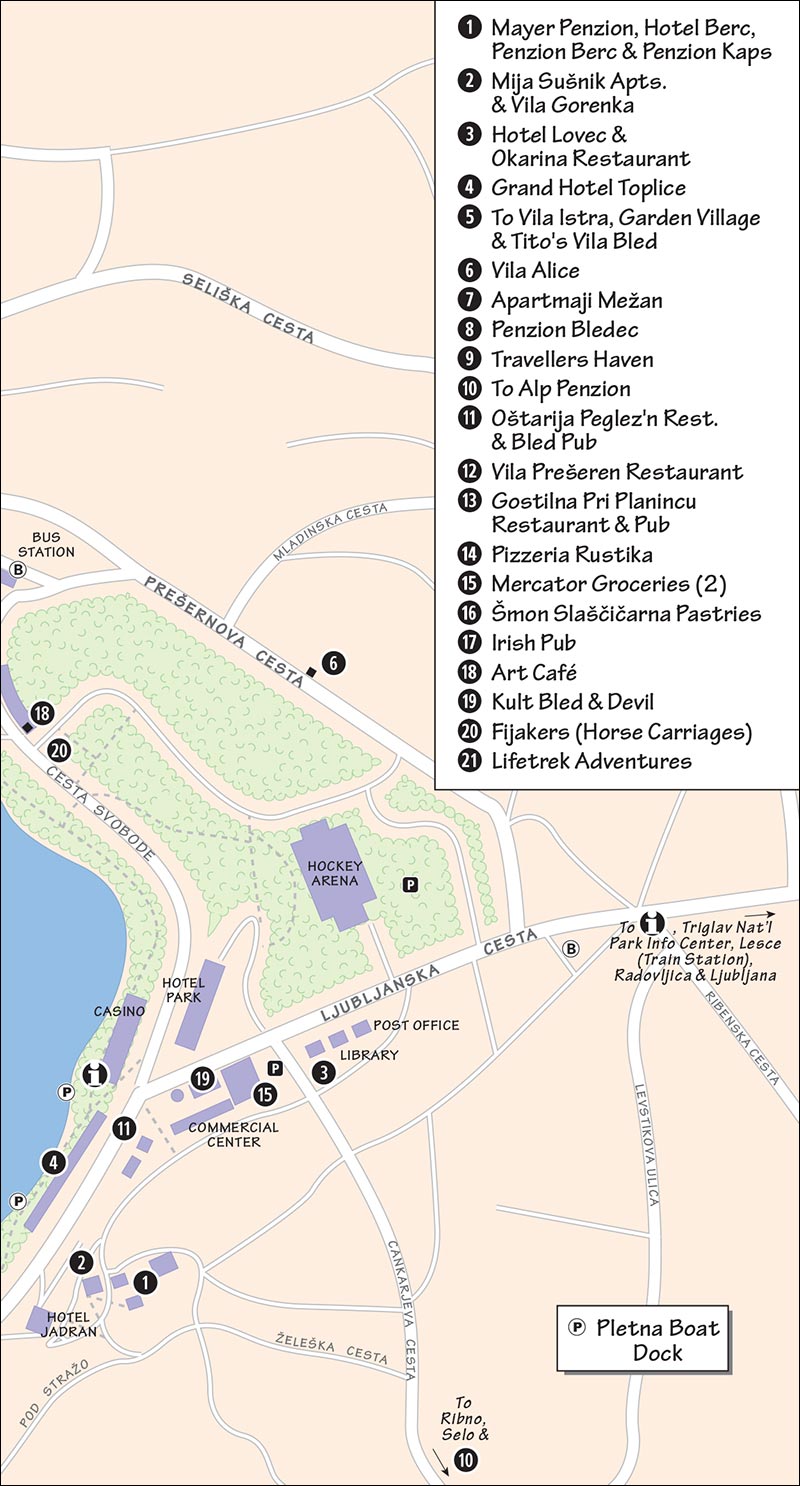

By Tourist Train: A little train makes a circuit around the lake every 40 minutes in summer (€4, daily 9:00-21:00 in peak season, shorter hours off-season, weather-dependent, mobile 051-337-478).
By Tourist Bus: A handy but pricey shuttle bus passes through Bled daily in the summer. It starts from the main bus station, stops at a few hotels (including Grand Hotel Toplice), then goes up to the castle and on to the Vintgar Gorge entrance (€2.30 one-way to Vintgar, €1.80 just to the castle, departs at 10:00 June-Sept and also at 9:00 July-Aug, confirm schedule at TI or bus station or check www.alpetour.si).
A different summertime bus is designed to reach villages to the east that are otherwise poorly served by public transportation, along with some larger towns such as Radovljica. The bus runs only two days a week, with a different route each day (€4/day, July-Aug Tue and Thu only, ask for schedule at TIs or hotel receptions).
By Taxi: Your hotel can call a taxi for you. Or contact Bled Tours, run by friendly, English-speaking driver Sandi Demšar and his girlfriend Cvetka (€10 to the castle or to Lesce-Bled train station, €14 to Radovljica, €50 to Ljubljana airport, €120 to Klagenfurt airport in Austria, office in Hotel Krim, Ljubljanska cesta 7, mobile 031-205-611, www.bledtours.si, info@bledtours.si).
By Boat: For information on renting your own boat, see “Boating” on here. For details on riding the characteristic pletna boats, see listing for “The Island” (here).
Tina Hiti and Sašo Golub, an energetic young couple, are both excellent guides who enjoy sharing the town and region they love with American visitors. Hiring one of them can add immeasurably to your enjoyment and understanding of Bled and the surrounding area (€45 for 2-hour tour of Bled, arrange several days in advance, info@pg-slovenia.com, Tina’s mobile 040-166-554, Sašo’s mobile 040-524-774, www.pg-slovenia.com). Tina and Sašo are especially handy for side-tripping into the countryside if you don’t want to drive yourself. I’ve spent great days with both of them and was thankful they were behind the wheel. Their most popular trip is a day in the Julian Alps (€190 round-trip from Bled, €230 to pick up or drop off in Ljubljana, extra charge for 5 or more people, ask about adding a picnic lunch for a small extra charge). They also offer many other options, including all-day shore excursions from the cruise port in Koper (€300 for a day visiting Ljubljana and Bled, up to 3 people), food tours, airport transfers, and trips in the Slovenian countryside to research your roots. As Tina and Sašo both lead tours for me in Europe—and have two young kids—they may send you off with a well-trained substitute. Tina’s father Gorazd, a former Yugoslav Olympian in ice hockey, brings the older generation’s perspective to the trip; Ervin provides a younger view; and Petra is well-versed in mountain herbs.
To hit several far-flung day-trip destinations in one go, consider a package tour from Bled. Destinations range from Ljubljana and the Karst region to the Austrian Lakes to Venice. For example, an all-day Julian Alps trip to the Vršič Pass and Soča Valley runs about €40 per person (sold by various agencies around town—ask the TI). This tour is handy, but two people can rent a car for the day for about the same price and do it at their own pace using the self-guided driving tour in the next chapter.
Various Bled-based companies specialize in taking tourists on active, outdoorsy excursions into the surrounding countryside and mountains. One popular, all-day trip is white-water rafting on the Soča River (around €90/person). Other options include canyoning, river tubing, mountain biking, paragliding, rock climbing, and more. Outfits include Lifetrek Adventures (near the bus station at Grajska 4, mobile 040-508-853, www.lifetrek-slovenia.com) and TinaRaft (based in Radovljica, mobile 041-646-255, www.tinaraft.si). Note that these companies tend to attract a young, sometimes-rowdy crowd that enjoys lubricating their adventures with alcohol.
If you have perfect weather and deep pockets, there’s no more thrilling way to experience Slovenia’s high-mountain scenery than from a small propeller plane soaring over the peaks. Flights depart from a grass airstrip near the village of Lesce, a 10-minute drive or taxi ride from Bled. Expensive...but unforgettable (€90 for 15-minute hop over Lake Bled only, €150 for 30-minute flight that also buzzes Lake Bohinj, €210 for deluxe 45-minute version around the summit of Triglav, arrange at least a day in advance, tel. 04/532-0100, www.alc-lesce.si, info@alc-lesce.si).
Bled doesn’t have many sights, but there are plenty of rewarding and pleasant activities.
Strolling the 3.5 miles around the lake is enjoyable, peaceful, and scenic. At a leisurely pace, it takes about an hour and a half...not counting stops to snap photos of the ever-changing view. On the way, you’ll pass some great villas, mostly from the beginning of the 19th century. The most significant one was a former residence of Marshal Tito—today the Hotel Vila Bled, a fine place to stop for a coffee and pretend Tito invited you over for a visit (described next). For the more adventurous, hiking paths lead up into the hills surrounding the lake (ask TI for details and maps; or hike to—and through—Vintgar Gorge, described on here).
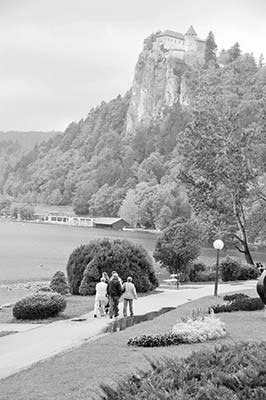
Before World War II, this villa on Lake Bled was the summer residence for the Yugoslav royal family. When Tito ran Yugoslavia, the part-Slovene communist leader took over the place and had it renovated using plans from the architect Jože Plečnik. During his heyday, Tito entertained international guests here (big shots from the communist and nonaligned world, from Indira Gandhi to Nikita Khrushchev to Kim Il Sung to Raúl Castro). Since 1984, it’s been a classy hotel and restaurant, offering guests grand Lake Bled views and James Bond ambience. The garden surrounding the villa is filled with exotic trees, brought here by Tito’s guests from distant lands.
The terrace has a restaurant that welcomes visitors to drop in for a meal, a piece of cake, or just a cup of coffee (reservations smart if you’re dining; likely closed Nov-March). Tito fans might want to splurge for an overnight (www.vila-bled.si). But even if you’re not a guest here, the hotel’s staff is generally tolerant of curious tourists poking around the public areas inside.
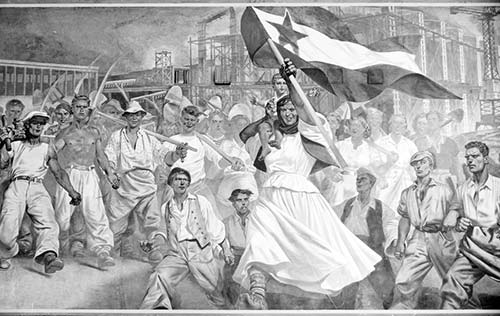
In the marbled lobby, ask to see Tito's original desk (on the way to the bar)—with a rare photo of Tito in civilian clothes. Then head upstairs to gawk at the Socialist Realist wall murals. These murals, decorating the upper walls of a vast ballroom on the second floor, are a fascinating peek at the propaganda of the time. Follow the rousing story of the origins of postwar Yugoslavia, starting on the upper left as you enter: First you see the Nazi destruction of Belgrade in 1941, a dark moment that inspired the South Slavs to band together to fight these foreign occupiers. See Tito raising his ragtag army, then leading them into pivotal battles in Bosnia-Herzegovina (notice the minaret and the destroyed bridge over the Neretva River), followed by a winter spent enduring hardship. At the end of this long wall, Tito’s victorious Partisans crush the final vestiges of the Nazis; in the upper-right corner, the spring blossoms represent a promising future for the people of Yugoslavia. The large panel at the end of the room trumpets the idealized postwar world that Tito envisioned: proud workers from all walks of life coming together for the betterment of Yugoslavia. In the shadow of a mighty factory—a symbol of heavy industry, which communists embraced as the way of the future—notice that the ironworker and the farmer are holding hands in unity. The room’s focal point is the mother hoisting a young child with one arm, and the flag of the nascent Socialist Federal Republic of Yugoslavia with the other.
Getting There: The villa is a 20-minute lakeside walk from the town of Bled at Cesta Svobode 26 (it’s the big, white villa with the long staircase at the southern end of the lake, just beyond the village of Mlino). You can also ask your pletna gondolier to drop you off here after visiting the island. Those hiking around the lake will pass the gate leading up through Tito’s garden to the restaurant and lobby.
Bled’s little island—capped by a super-cute church—nudges the lake’s quaintness level over the top. Locals call it simply “The Island” (Otok). While it’s pretty to look at from afar, it’s also fun to visit.
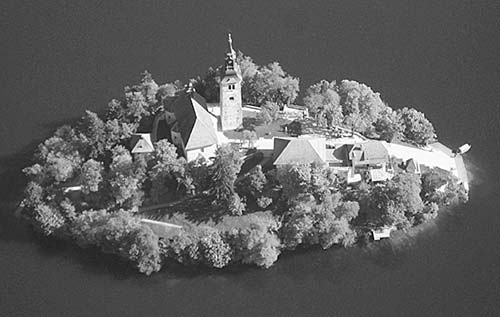
The island has long been a sacred site with a romantic twist. On summer Saturdays, a steady procession of brides and grooms, cheered on by their entourages, heads for the island. Ninety-nine steps lead from the island’s dock up to the Church of the Assumption on top. It’s tradition for the groom to carry—or try to carry—his bride up these steps. About four out of five are successful (proving themselves “fit for marriage”). During the communist era, the church was closed and weddings were outlawed here. But the tradition reemerged—illegally—even before the regime ended, with a clandestine ceremony in 1989.
Cost and Hours: Free to visit island, church-€6, ticket includes tower climb, daily May-Sept 9:00-19:00, April and Oct until 18:00, Nov-March until 16:00.
Getting There: The most romantic route to the island is to cruise on one of the distinctive pletna boats (€12/person round-trip, includes 30-minute stay on the island; catch one at several spots around the lake—most convenient from in front of Grand Hotel Toplice or just below Hotel Park, might have to wait for more passengers to fill the boat; boats generally run from dawn, last boat leaves one hour before church closes; replaced by enclosed electric boats in winter—unless the lake freezes, in which case you can rent ice skates; mobile 031-316-575). Other places to catch a pletna include the village of Mlino, partway around the lake; the bottom of the grand staircase leading up to Vila Bled (it’s a shorter trip from here, but the same cost); and at the campground. For more on these characteristic little vessels, see the “Pletna Boats” sidebar. Note that pletna boatmen stick close to the 30-minute waiting time on the island—which can go very fast. For more time, you can rent your own boat and row to the island (see Boating listing, later). It’s even possible to swim, especially from the end of the lake nearest the island (see “Swimming” listing, later), but you’re not allowed into the church in your swimsuit. Guess you’ll just have to go in naked.
Visiting the Island: At the top of the stairs, the Potičnica café sells potica, the Slovenian nut-roll cake that’s traditional at Christmastime but delicious any day of the year. The attached souvenir shop is the best in Bled, well-stocked with a variety of high-quality Slovenian gifts, trinkets, and keepsakes.
Upstairs in the same building is the worthwhile but easy-to-miss art gallery, which displays changing exhibits as well as a wonderful permanent exhibit commemorating Slovenia’s membership in the EU. Local sculptor Ladina Kurbor has created finely detailed clay figurines clad in the traditional national costume from each of the European Union member nations. The attached room houses figurines wearing traditional dress from various parts of Slovenia (identified on the map and explained by the posted descriptions).
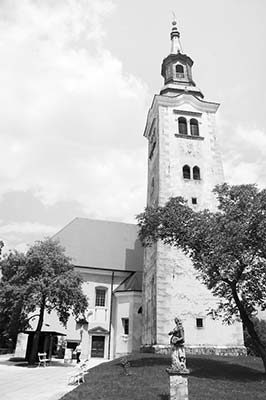
The island’s main attraction is the church. An eighth-century Slavic pagan temple dedicated to the goddess of love and fertility once stood here; the current Baroque version (with Venetian flair—the bell tower is separate from the main church) is the fifth to occupy this spot. Go inside and find the rope for the church bell, hanging in the middle of the aisle just before the altar. A local superstition claims that if you can get this bell to ring three times with one big pull of the rope, your dreams will come true. Worth a try—but be careful if you’re slight of build, as the rope can take you for a ride.
If you’re waiting for a herd of tourists to ring out their wishes, pass the time looking around the area in front of the altar. When the church was being renovated in the 1970s, workers dug up several medieval graves (you can see one through the glass under the bell rope). They also discovered Gothic frescoes on either side of the altar, including, above the door on the right, an unusual ecclesiastical theme: the bris (Jewish circumcision ritual) of Christ.
Your ticket also includes the bell tower. At 91 steps, it’s a shorter climb than the one up from the boat dock. Up top, you’ll find a restored pendulum mechanism from 1890 and fine lake views that are marred by a mesh covering that makes it impossible to snap a clear picture.
To descend by a different route, walk down the trail behind the church (around the right side), then follow the path around the island’s perimeter back to where your pletna boat awaits.
Bled’s cliff-hanging castle, dating in one form or another from 1,000 years ago, was the seat of the Austrian bishops of Brixen, who controlled Bled in the Middle Ages. Today it’s merely a fine tourist attraction with a little history and lots of big views. The various sights at the castle—a decent history museum, a frescoed chapel, an old-fashioned printing press, and a wine cellar—are more cute than interesting, but the real reason to come up here is to bask in the sweeping panoramas over Lake Bled and the surrounding mountainscapes.
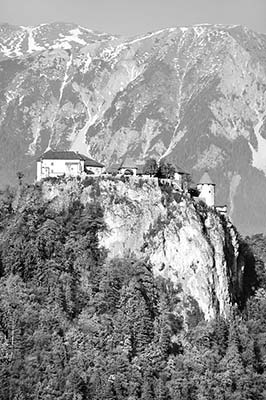
Cost and Hours: €9, daily May-Oct 8:00-20:00, Nov-April 9:00-18:00, printing press and wine cellar close one hour earlier; tel. 04/572-9782, www.blejski-grad.si.
Getting There: To really earn those views, you can hike up the steep hill (20-30 minutes). The handiest trails are behind big St. Martin’s Church: Walk past the front door of the church with the lake at your back, and look left after the first set of houses for the Grad signs marking the steepest route (follow the wooden stakes all the way up the steep switchback steps); or, for a longer but less steep route, continue past the church on the same street about five minutes, bearing uphill (left) at the fork, and find the Grad 1 sign just after the Penzion Bledec hostel on the left. Once you’re on this second trail, don’t take the sharp-left uphill turn at the fork (instead, continue straight up, around the back of the hill). If you’d rather skip the hike, you can take the morning tourist bus (see “Getting Around Lake Bled,” earlier), your rental car, a taxi (around €12), or—if you’re wealthy and romantic—a horse and buggy (€40, €10 extra for driver to wait 30 minutes and bring you back down). However, all of these options take you only to the parking lot, from which it’s still a steep and slippery-when-wet five-minute hike up to the castle itself.
Eating: The $$$$ restaurant at the castle is pricey, but worth the splurge for the views and excellent menu featuring regional cuisine. Come for dinner while it’s still light out and savor the setting. There’s good seating inside, but it’s even better on the outside terrace. Call ahead to book a view table—but do it soon, as this popular place books up quickly. If you have a reservation to dine here, it's free to enter the castle grounds (daily in summer 10:00-22:00, shorter hours off-season, tel. 04/579-4424, www.jezersek.si). Paupers can bring their own picnic to munch along the wall with million-dollar views over Lake Bled (buy sandwiches at the Mercator grocery store in the commercial center before you ascend—see here).
Visiting the Castle: After buying your ticket, go through the gate and huff the rest of the way up to the outer courtyard. We’ll tour the castle clockwise, starting from here. As the castle is continually being spruced up, some details may be different than described.
Turning left at the entrance, you’ll pass WCs, then the door to Mojster Janez’s working replica of a printing press (grajska tiskarna/manufaktura) from Gutenberg’s time. You can buy your own custom-made souvenir certificate using this very old technology. While this may seem like a tourist gimmick, there’s actually some interesting history here. As in many lands, the printing press was a critical tool in the evolution of Slovenia’s culture. Look above the press for a life-size mannequin of Primož Trubar (1508-1586), a Slovenian cross between Martin Luther and Johannes Gutenberg. In Trubar’s time, Slovene was considered a crude peasants’ language—not just unworthy of print, but actually illegal to print. So this Reformer went to Germany and, in 1550—using presses like this one—wrote and printed the first two books in the Slovene language: Abecedarium (an alphabet primer to teach illiterate Slovenes how to read) and Catechismus (a simplified version of the New Testament). Trubar smuggled his printed books back to Slovenia (hidden in barrels of playing cards) and, en route to Ljubljana, was briefly given refuge in this castle. (Trubar is still much-revered today, appearing on the Slovenian €1 coin.) Up the stairs is an exhibition in English about early printing methods and the importance of moveable type for advancing the Protestant Reformation, whose goal was to get the Word of God more easily into the hands of everyday people. You’ll also see one of those first Trubar books—notice it was printed in Tübingen, Germany, an early enclave of the Reformation.
Just past the printing press is the castle’s oldest tower—from the 11th century—and a café terrace offering pricey drinks with grand views.
Continue past the café and begin climbing the stairs up to grander and grander views over the lake. Reaching the terrace at the very top, you’ll find the best vistas; the restaurant; a tiny chapel with 3-D frescoes that make it seem much bigger than it is (next to the museum entrance); a small shop selling iron items that are still forged the traditional way; and the well-presented castle museum, which strains to make the story of Bled, the castle, and the surrounding region of Carniola interesting. The ground floor has exhibits about geology, prehistoric artifacts, ironworking, and the seasonal life cycle of the region, while the upstairs has a cool 3-D model of the surrounding mountains, smaller models illustrating the growth of the building, more prehistory, and exhibits on the development of tourism at Lake Bled (including its many fine vacation villas). While video screens and some English information are helpful, there’s only so much to say.
When you’re done up here, head down the stairs between the museum and restaurant (passing WCs). Coming back down into the lower courtyard, turn left down the ramp to find the wine cellar, where you can pay a hefty €14-17 to bottle and cork your own souvenir bottle of wine (you’re paying for the experience more than the wine). Slovenian wines are well-explained by one of two guys (both, coincidentally, named Andrej) who dress as monks, since winemaking was a monastic responsibility in the Middle Ages.
Before leaving the castle, climb the stairs up to the wooden defensive gallery for the best views in town of the mountains east of Bled. The biggest one is called Stol (“Chair”). In the foreground, you can see the steeple marking the town of Podhom; just to the left, the folds in the hills hide the dramatic Vintgar Gorge (see here). The gallery leads to the round tower, with an exhibit on a Bled tourism pioneer and a fun "multivision" presentation about nearby activities.
Bled is the rowing center of Slovenia. Town officials even lengthened the lake a bit so it would perfectly fit the standard two-kilometer laps, with 100 meters more for the turn (on maps, you can see the little divot taken out of the far end). Bled hosted its fourth world championship in August 2011. The town has produced many Olympic medalists, who’ve won gold in Sydney, silver in Athens, and bronze in London. Notice that local crew team members, whom you’ll likely see running or rowing, are characters—with a tradition of wild and colorful haircuts. This dedication to rowing adds to Bled’s tranquility, since no motorized boats are allowed on the lake.
If you want to get into the action, you’ll find rental rowboats at various points around the lake (€10-20/hour). Look for them at Pension Pletna in the lakeside village of Mlino (a scenic 15-minute walk around the lake from Bled); at the swimming pool under the castle (the closest but priciest option); and in the modern building just before the campground on the far end of the lake.
Lake Bled has several suitable spots for a swim. The swimming pools under the castle are filled with lake water and routinely earn the “blue flag,” meaning the water is top-quality (swim all day-€7, less for afternoon only, mid-June-Sept daily 8:00-19:00, closed Oct-mid-June and in bad weather, tel. 04/578-0528). Lake Bled’s main beach is at the campground at the far end of the lake, though you can also swim near the village of Mlino. If you swim to the island, remember that you can’t enter the church in your swimsuit.
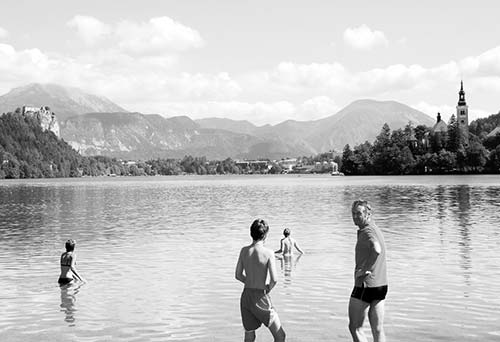
Bled’s “summer toboggan” luge ride, atop Mount Straža overlooking the lake, allows you to scream down a steep, curvy metal rail track on a little plastic sled. This is a really scary one—speedy, with lots of tight turns, and with great views over the lake—but it’s quite pricey. A chairlift takes you to the top of the track, where you’ll sit on your sled, take a deep breath, and remind yourself: Pull back on the stick to slow down, push forward on the stick to go faster. You’ll drop 480 feet in altitude on the 570-yard-long track, speeding up to about 25 miles per hour as you race toward the lake.
Cost and Hours: €9/ride, cheaper for multiple rides, chairlift only-€4, weather-dependent—if it rains, you can’t go. In summer, it’s open daily (late June-Aug 10:00-20:00, early Sept 11:00-18:00). In shoulder season, it’s Sat-Sun only (mid-April-late June generally 11:00-18:00, late Sept-mid-Oct 11:00-17:00). It’s closed off-season (mid-Oct-early April).
Getting There: The base of the chairlift is on the hillside just south of town, beyond Grand Hotel Toplice and just behind the Hostel Vila Viktorija.
Next to the luge at the top of Mount Straža, this park has a series of five high-ropes courses designed for everyone from five-year-olds to adults. You’ll get rigged up in a safety harness and go through a training course, then be set loose on your choice of courses (with help from spotters on the ground); plan on spending about two hours to do all of them. It’s a steep hike up the hill, or you can pay €4 to ride the chairlift for the luge ride (or pay more to ride the chairlift up and luge back down).
Cost and Hours: €20 for adults, €16 for kids 7-14, €10 for kids under 7, late June-Aug daily 10:00-20:00, first half of Sept daily 11:00-18:00, shorter hours and Sat-Sun only rest of season, closed late Oct-early April, last entry two hours before closing, mobile 031-761-661, www.pustolovski-park-bled.si.
Tucked in Selo village, a long walk or short drive from Bled, this fascinating countryside sight is worth ▲▲▲ (or zzz) for fans of the apicultural arts. (First, read up on beekeeping on here.) Local beekeeper Blaž Ambrožič has built an apiary (freestanding house of beehives) and teaches visitors all about this very Slovenian form of agriculture. First you’ll see the painted panels, with bees buzzing in and out. Blaž’s prize possession is a gigantic Winnie-the-Pooh-style hive that he transplanted from a tree trunk. He’ll demonstrate how you can hold your hand within inches of the buzzing hive without getting stung, thanks to the peaceful nature of the indigenous Carniolan bee. Inside, you can watch through a big (and safe) window as Blaž pulls out the honeycomb frames from the hive and works with his bees. You can sample (and buy) different types of honey, along with other bee-related gifts. Outside is a perennial garden that demonstrates when various plants blossom, providing much-needed pollen for the bees.
Cost and Hours: €4/person, call or email a day ahead to arrange a time, demonstrations usually last an hour or more and may even run for just two people, Selo pri Bledu 26, tel. 041-657-120, www.kralov-med.si, blazambrozic@gmail.com.
Getting There: Blaž’s beehives are in the village of Selo, a five-minute drive or taxi ride or 40-minute walk from Bled town. Head out of town along the lake (past Grand Hotel Toplice), then turn left (inland) at the village of Mlino. In the next village, Selo, look for the two colorful beehive apiaries along the main road, just above the recommended Tourist Farm Mulej.
Bled is quiet after hours. However, the town does have a few fun bars that are lively with a young crowd (all open nightly until late). Since many young people in Bled are students at the local tourism school, they’re likely to speak English...and eager to practice with a native speaker. Try a Smile, a Corona-type Slovenian lager. Šnops (schnapps) is a local specialty—popular flavors are plum (slivovka), honey (medica), blueberry (borovničevec), and pear (hruškovec).
Kick things off with the fun-loving local gang at Gostilna Pri Planincu near the bus station (described later, under “Eating in Bled”). Then head down Cesta Svobode toward the lake; just below Hotel Jelovica, you’ll find the rollicking Irish Pub (a.k.a. “The Pub”), with Guinness and indoor or outdoor seating. For the hippest scene in town, duck across the street and wander a few more steps down toward the lake to find the Art Café, with a mellow ambience reminiscent of a Van Gogh painting. Around the lake near the commercial center, Bled Pub (a.k.a. “The Cocktail Bar” or “Troha”—for the family that owns it) is a trendy late-night spot where bartenders sling a dizzying array of mixed drinks to an appreciative, youthful crowd (between the commercial center and the lake, above the recommended Oštarija Peglez’n restaurant). If you’re still standing, several other bars and cafés percolate in the commercial center, including Kult Bled, facing the main road. Slathered with iconic film images and neon colors, it attracts a thirtysomething crowd and occasionally hosts live music. Devil is open even later (also in the commercial center, near the ATM).
Bled has more hotel beds per capita than anywhere in Slovenia—and most of them are in big convention hotels. I prefer staying in smaller, more characteristic, pension-type accommodations on the town’s fringe—most of them an easy walk from the lake. These quaint little family-run places book up early with Germans and Brits; reserve well ahead. For even cheaper beds, consider one of the many sobe (rooms in private homes) scattered around the lake; look for signs in the neighborhood just above Prešernova cesta.
These friendly, cozy, characteristic accommodations are Bled’s best values. The only catch is that they’re perched on a hilltop a 5- to 10-minute climb up from the lake (easier than it sounds). There are two ways to find these from the town center: Walk around the lake to Grand Hotel Toplice, then go up the stairs around the right side of the Hotel Jadran (on the hill across the street from Grand Hotel Toplice). Or, from the main road into town (Ljubljanska cesta), take the small service road just above the commercial center (in front of Hotel Lovec), and loop up around the big Kompas and Golf hotels. If arriving by bus, ask nicely if your driver will let you disembark along Ljubljanska cesta (just above the traffic light) to avoid the long walk from the bus station. From this bus stop, you can walk down Ljubljanska cesta and take the road just above the post office, which leads up to this area. If you’re sleeping up here, Penzion Berc and Mayer Penzion both have great restaurants (described later, under “Eating in Bled”).
$$ Mayer Penzion, thoughtfully run by the Trseglav family, comes with 13 great-value rooms, a helpful staff, a tasty restaurant, an atmospheric wine-tasting cellar, and beautifully handcrafted Slovenian woodwork. They book up fast in summer with return clients, so reserve early (family deals, elevator, Želeška cesta 7, tel. 04/576-5740, www.mayer-sp.si, penzion@mayer-sp.si). They also rent a cute, newly restored two-story Slovenian farm cottage next door.
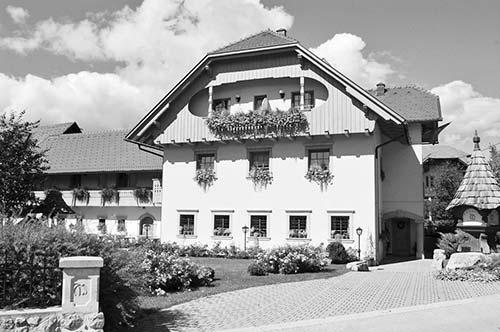
$$ Hotel Berc and Penzion Berc (pronounced “berts”), run by the Berc brothers, are next door to Mayer Penzion and flank a romantic outdoor restaurant. Both have cozy public spaces, balconies off every room, and free loaner bikes, and are worth reserving ahead (both cash only). The hotel building has 15 rooms with pleasantly woody decor (Pod Stražo 13, tel. 04/576-5658, www.berc-sp.si, hotel@berc-sp.si, run by Luka). The adjacent penzion offers 10 very sharp rooms (closed Nov-Christmas and sporadically off-season, Želeška cesta 15, tel. 04/574-1838, www.berc-sp.si, penzion@berc-sp.si; run by Miha, who also offers local excursions).
$$ Penzion Kaps, owned by Peter (whose father, Anton, is a great craftsman), has 13 comfortable rooms with balconies, modern bathrooms, and classic old wood carvings in a Shangri-La kind of place. The inviting breakfast room clusters around a giant ceramic stove (cash only, free loaner bikes, Želeška cesta 22, mobile 059-117-746, www.penzion-kaps.si, info@penzion-kaps.si).
$ Friendly Mija Sušnik rents out two comfortable apartments. Modern, tidy, and equipped with kitchens, these are a good budget choice for families (no breakfast, cash only, laundry service, free parking, Želeška cesta 3, tel. 04/574-1731, susnik@bled-holiday.com). It’s just toward the lake from the bigger pensions, with a big crucifix out front. Her sister Ivanka also rents apartments, but they’re farther from the lake.
¢ Vila Gorenka is your low-budget, no-frills option. The Žerovec family’s old-fashioned house has eight faded and musty rooms; three of them have their own bathrooms, while the rest share two other bathrooms. Room #10 has a grand-view balcony (cash only, breakfast extra, closed Nov-Easter, just below the bigger pensions at Želeška cesta 9, mobile 040-958-624, http://freeweb.siol.net/mz2, vilagorenka@gmail.com, Janez).
You’ll pay a premium to be closer to the lake—but it’s hard to argue with the convenience.
$$$$ Hotel Lovec (LOH-vets), a Best Western Premier, sits in a convenient (but nonlakefront) location just above the commercial center. Gorgeously renovated inside and out, and run by a helpful staff, it’s professional yet welcoming and cheery. Its 60 plush rooms come with all the comforts and a respected restaurant (family rooms, delicious breakfast, elevator, indoor pool, free parking, Ljubljanska cesta 6, tel. 04/620-4100, www.lovechotel.com, reservations@kompas-lovec.com).
$$$$ Grand Hotel Toplice (TOHP-leet-seh) is the grande dame of Bled, with 87 high-ceilinged rooms, parquet floors, a genteel lakeview café/lounge, posh decor, all the amenities, and a long list of high-profile guests—from Madeleine Albright to Jordan’s King Hussein to Slovene-by-marriage Donald Trump (ask to see their “wall of fame”). Once elegant, this place is a bit faded these days, but it’s still a classic. Rooms in the back are cheaper, but have no lake views and overlook a noisy street—try to get one as high up as possible (air-con, elevator, free one-hour boat rental for guests, free parking, Cesta Svobode 12, tel. 04/579-1000, www.hotel-toplice.com, ghtoplice@hotelibled.com). The hotel’s name—toplice—means “spa”; guests are free to use the hotel’s swanky, natural-spring-fed indoor swimming pool (a chilly 72 degrees Fahrenheit).
$$$ Vila Istra is housed in a prominent and gorgeously restored Art Nouveau villa from 1887. The remarkably spacious rooms include one double and five sprawling suites. Room furnishings gild the lily a bit, but respect the history of the building. It’s a scenic 15-minute walk outside of the town center, almost to the village of Mlino (air-con, Cesta Svobode 35, mobile 059-080-808, www.vila-istra.info, booking@bled.net).
$$$ Vila Alice, a beautifully appointed option on a busy road in the sleepy upper part of town, offers seven rooms in a classy villa with elegant public spaces, a private garden, and a sauna (air-con in some rooms, free parking, reception open daily 7:00-22:00, convenient for drivers at Prešernova cesta 26, mobile 040-231-303, www.vila-alice.com, info@vila-alice.com).
¢ Apartmaji Mežan, run by welcoming Janez and Saša, has four family-friendly apartments in a modern home buried in the middle of town, just uphill from the church. As it’s next to an old barn, it’s technically a tourist farm (cash only, no breakfast, Riklijeva 6, mobile 041-210-290 or 041-516-688, www.apartmaji-mezan.si, sasa.mezan@gmail.com).
¢ Penzion Bledec (BLED-ets), a family-run, official IYHF hostel, is just below the castle at the top of the Old Town. Each of the 12 rooms has its own bathroom. They have dorms, private rooms, and great family rooms (full-service laundry for guests, restaurant, Grajska 17, tel. 04/574-5250, www.bledec.si, info@bledec.si).
¢ Travellers Haven is a low-key hostel run with a smile by Mirjam. The 31 beds fill eight rooms in a nicely renovated hundred-year-old villa in the Old Town. The lodgings are well maintained and the hangout areas are inviting, though the tight bathrooms offer little privacy (reception open 8:00-13:00 & 16:00-23:00, laundry machines, rental bikes, Riklijeva cesta 1, mobile 041-396-545, www.travellers-haven.si, travellers-haven@t-2.net).
The following listings are a bit farther out: Alp Penzion is a 20-minute walk from the lakefront, but still doable for nondrivers, while the tourist farm and “glampground” are best for drivers.
$$$$ Garden Village is very expensive...but very cool. Alternately billed as a “glampground” and a “green resort,” this splurge combines the closeness to nature of camping with the amenities of a hip resort. From the main lodge, restaurant, and rustic pond/pool, the complex tumbles down a ravine toward a gushing river, connected by slippery plank walks. You can choose between the tree house (with a loft and netted hammock area up top for kids); the glamping tents, with canvas walls and nestled in an abundant produce garden; or the simpler pier tents, actually on stilts over the river. All of these include breakfast, Wi-Fi, and other amenities, but additional charges for cleaning and shorter stays can really add up (on the road toward Lake Bohinj, turn off on the left just before Vila Bled, Cesta Gorenjskega odreda 16, tel. 08/389-9220, www.gardenvillagebled.com, reservations@gardenvillagebled.com).
$ Alp Penzion makes the most of a peaceful countryside setting amid hayfields, within a 20-minute, partly uphill walk of the lake (better for drivers or for those who don’t mind the walk). With 12 rooms (some with balconies), this kid-friendly place is enthusiastically run by the Sršen family, who offer lots of fun extras, including a summer barbecue grill/outdoor pub (family rooms, dinner possible in summer—ask when you book, air-con, free loaner bikes, Cankarjeva cesta 20A, for location see map on here, tel. 04/574-1614, www.alp-penzion.com, bled@alp-penzion.com). Just next door is the relaxing Essense spa (described earlier, under “Helpful Hints”).
$ Tourist Farm Mulej, possible for hardy walkers but much better for drivers, is a new but traditional farmhouse in a tranquil valley about a half-mile from the lake (1.5 miles from Bled town). Damjana and Jože, who run this working farm (with 70 milk cows...and their smells), also rent out eight modern rooms and four apartments—all with balconies—and serve breakfasts and dinners made with food they produce. Be sure to see the udderly fascinating, fully automated cow-milking machine called Lely, who’s practically a member of the family (cash only, family rooms, air-con, free loaner bikes, horseback riding free for experienced guests, Selo pri Bledu 42a, tel. 04/574-4617 or 04/022-4888, www.mulej-bled.com, info.mulej@gmail.com). It’s in the farm village of Selo—drive along the lakeside road south from Bled, then turn off in Mlino toward Selo, and look for the signs (to the right) once in the village. For the location, see the map on here.
(See “Bled Town” map, here.)
Bled has several good restaurants, but most everything is quite similar. For variety, wait for Ljubljana.
$$$$ Okarina, run by charming, well-traveled Leo Ličof (who may be retiring soon), serves a diverse array of cuisines, all of them well-executed: international fare, traditional Slovenian specialties (with an emphasis on game), and Indian (Himalayan) dishes. Leo has a respect for salads and vegetables and a passion for fish. Creative cooking, fine presentation, friendly service, and an atmosphere as tastefully eclectic as the food make this place a great splurge (Mon-Fri 12:00-15:00 & 18:00-23:00, Sat-Sun 12:00-23:00, closed Nov-mid-April, next to recommended Hotel Lovec at Ljubljanska cesta 8, tel. 04/574-1458).
$$$ Oštarija Peglez’n (“The Old Iron”), conveniently located on the main road between the commercial center and the lake, cooks up tasty Slovenian and Mediterranean meals, with an emphasis on fish and fun, family-style shareable plates. Choose between the delightful Slovenian cottage interior or the shady streetside terrace. Reservations are smart in summer (daily 12:00-23:00, Cesta Svobode 19A, tel. 04/574-4218).
$$$ Vila Prešeren is the best lakeside choice, featuring mod decor, good international cuisine (as well as some traditional Slovenian dishes), and tables on a giant terrace reaching down to the lakefront. This is a great spot to linger over a meal, a drink, or a classic Lake Bled dessert (daily 7:00-23:00, Veslaška promenada 14, tel. 04/575-2510).
In the B&B Zone Above Town: Just up the hill from the lakefront, two recommended B&Bs run restaurants ideal for dinner in a lovely setting. At either place, it’s smart to reserve ahead—especially in summer. $$$ Fine Food Berc is a dreamy splurge restaurant (operated by the recommended Penzion Berc). You’ll dine at white-tablecloth tables positioned just so on the lush lawn or in the cutesy interior—both come with live piano music. Reservations are smart (May-Sept daily 17:00-23:00, Želeška cesta 15, tel. 04/574-1838). Next door, $$$ Mayer Penzion runs a classy restaurant with fine traditional cooking and good seating inside and out. This is where a Babel of international tourists comes to swap hiking tips and day-trip tales (limited menu, Tue-Sun 18:00-24:00, closed Mon, Želeška cesta 7, tel. 04/576-5740).
$$ Gostilna Pri Planincu (“By the Mountaineers”) is a homey, informal bar coated with license plates and packed with fun-loving and sometimes-rowdy natives. A larger dining area sprawls behind the small, local-feeling pub, and there’s outdoor seating out front and on the side patio. The menu features huge portions of stick-to-your-ribs Slovenian pub grub, plus Balkan grilled-meat specialties. Look for their huge, home-style traditional daily specials. Upstairs is a timbered pizzeria dishing up wood-fired pies (daily 9:00-23:00, pizzeria open from 11:00, Grajska cesta 8, tel. 04/574-1613). The playful cartoon mural along the outside of the restaurant shows different types of mountaineers (from left to right): thief, normal, mooch (“gopher”), climber, and naked (...well, almost).
$$ Pizzeria Rustika, in the Old Town, offers wood-fired pizzas and salads. Its upstairs terrace is relaxing on a balmy evening (daily 12:00-23:00, service can be slow when it’s busy, Riklijeva cesta 13, tel. 04/576-8900).
Supermarket: The $ Mercator grocery store, in the commercial center, has the makings for a bang-up picnic. They sell sandwiches to go for about €3, or will make you one to order (point to what you want). This is a great option for hikers and budget travelers (Mon-Fri 7:30-20:30, Sat 7:00-15:00, Sun 8:00-12:00). There’s another location closer to the Old Town and castle (Mon-Sat 7:00-20:00, Sun 8:00-16:00).
Dessert: While tourists generally gulp down their cream cakes on a hotel restaurant’s lakefront terrace, residents favor the desserts at Slaščičarna Zima (a.k.a. the “Brown Bear,” for the bear on the sign). It’s nicely untouristy, but lacks the atmosphere of the lakeside spots (daily 7:30-21:00, near bus station at Grajska cesta 3, tel. 04/574-1616).
$$$$ Vila Podvin, in the village of Mošnje (about a 15-minute drive from Lake Bled, just past Radovljica), has gained a big culinary reputation in recent years. The talented celebrity chef, UrošŠ (who has hosted some popular Slovenian cooking shows), prides himself on melding traditional Slovenian recipes with modern techniques and flavors. The dressy but inviting interior and fine garden are equally enjoyable places to dine. Their lunch special—available until 15:00—is a nice way to affordably sample their menu. Reservations are smart (Tue-Sat 12:00-22:00, Sun 12:00-17:00, closed Mon, Mošnje 1, tel. 08/384-3470, www.vilapodvin.si). They also rent very sharp rooms and offer cooking classes (explained on their website).
The most convenient train connections to Bled leave from the Lesce-Bled Station, about 2.5 miles away (see details under “Arrival in Bled,” earlier). Remember, when buying a train ticket to Lake Bled, make it clear that you want to go to the Lesce-Bled Station (not the Bled Jezero Station, which is poorly connected to the main line). No one in the town of Bled sells train tickets; buy them at the station just before your train departs (open Mon-Fri 5:30-21:00, Sat 7:00-15:00, Sun 14:30-19:30). If the ticket window there is closed, buy your ticket on board from the conductor (who will likely waive the surcharge).
Note that if you’re going to Ljubljana, the bus (which leaves from Bled town itself) is better than the train (which leaves from the Lesce-Bled train station).
From Lesce-Bled by Train to: Ljubljana (roughly hourly, 40-60 minutes), Salzburg (3/day, 4 hours, some change in Villach, Austria), Munich (3/day, 5.5 hours, some change in Villach), Vienna (that’s Dunaj in Slovene, 3/day, 5.25-6 hours, change in Villach), Venice (2/day with transfers in Villach—one partway by bus, 6-6.5 hours; instead consider a GoOpti minibus—described on here), Zagreb (4/day direct, 3-3.5 hours).
By Bus to: Ljubljana (Mon-Sat hourly—usually at :30 past the hour, fewer on Sun, 1.25 hours), Radovljica (Mon-Fri at least 2/hour, Sat hourly, Sun almost hourly, 15 minutes), Lesce-Bled train station (2/hour, 10 minutes), Lake Bohinj (hourly, 40 minutes to Bohinj Jezero stop, 50 minutes to Bohinj Vogel or Bohinj Zlatorog stop, 3/day in summer continue all the way to Savica Waterfall trailhead), Podhom (15-minute hike away from Vintgar Gorge, Mon-Fri 5/day in the morning, 1/day Sat, none Sun, 15 minutes), Spodnje Gorje (also 15-minute hike from Vintgar Gorge, take bus in direction of Krnica, hourly, 15 minutes). Confirm times at the TI or by using the schedules posted at the unstaffed Bled bus station. Buy tickets on the bus.
By Plane: Ljubljana Airport (airport code: LJU) is between Lake Bled and Ljubljana, about a 45-minute drive from Bled. Connecting by taxi costs around €60 (set price up front—since it’s outside of town, they don’t use the meter; be sure to use a Bled-based taxi because a Ljubljana-based taxi will likely be more expensive). The Zup Prevozi shuttle bus is a more affordable option at €13, but it runs only a few times each day (generally coordinated to meet EasyJet flights—see schedule at www.zup-prevozi.eu). Another option is to prearrange a shared shuttle service with either GoOpti (see description on here) or Zup Prevozi. The public bus connection from Bled to the airport is cheap (total cost: about €6) but complicated and time-consuming: First, go to Kranj (Mon-Fri 12/day, Sat-Sun 8/day, 35 minutes), then transfer to a Brnik-bound bus (at least hourly, 20 minutes). Many Bled residents prefer to fly from Klagenfurt, Austria. For details on both the Ljubljana and Klagenfurt airports, see here.
Route Tips for Drivers: Bled is less than an hour north of Ljubljana on the slick A-2 expressway. The exit is marked for Lesce, but you’ll also see signs for Bled, which will lead you directly to the lake (where the road becomes Ljubljanska cesta).
To reach Radovljica (bee museum) or Lesce (train station), drive out of Bled on Ljubljanska cesta toward the expressway. Watch for the turnoff to Lesce on the right. They’re on the same road: Lesce first (to reach train station, divert right when entering town), then Radovljica. (Signs to Radovljica will divert you out to the main road that parallels the expressway, then back down into Radovljica; instead, you could follow signs to Lesce, and drive through that town for the more direct route.)
The countryside around Bled offers several day trips that can be done easily without a car (bus connection information is described in each section). The three trips listed here are the best (one small-town/museum experience, two hiking/back-to-nature options). They’re more convenient than can’t-miss, but each is worthwhile on a longer visit, and all give a good taste of the Julian Alps. For a self-guided driving tour through farther-flung (and even more striking) parts of the Julian Alps, see the next chapter.
For those seeking an easy yet spectacular walk, Vintgar (VEENT-gar), worth ▲▲, is one of my favorite low-impact hikes in Slovenia. Just north of Bled, the river Radovna has carved this mile-long, picturesque gorge into the mountainside. Boardwalks and bridges put you right in the middle of the magic in this “poor man’s Plitvice.” Shaded and relatively cool, this is a refreshing place for a walk on a hot day.
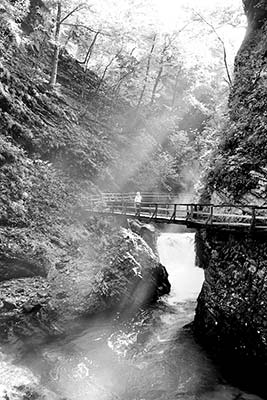
The gorge—easily reachable from Bled by bus or foot—works well for those who are itching for a hike but don’t have a car. From the entrance, allow about 1.5 hours for a round-trip hike, including time for photos (and there will be photos). On sunny days, the gorge can be crowded (and less idyllic) after about 11:00—if you anticipate crowds, get an early start.
Cost and Hours: €4 to enter gorge, open daily April-Oct 8:00-19:00 or until dusk, June-Aug maybe until 20:00, closed Nov-March, tel. 04/572-5266.
Getting to Vintgar Gorge: The gorge is 2.5 miles north of Bled. To reach the gorge entrance, you can walk (takes at least one hour one-way), pedal a rental bike (about 30 minutes, easiest with an electric bike), take a bus (15-minute ride plus 15-minute walk, or 30-minute ride on summer tourist bus), or drive (less than 10 minutes).
Walkers and cyclists leave Bled on the road between the castle and St. Martin’s Church and take the uphill (left) road at the fork. Just after the little yellow chapel, turn right on the road with the big tree, then immediately left at the Mercator grocery store. When the road swings left, continue straight onto Partizanska (marked for Podhom and a walking sign for Vintgar; ignore the bus sign for Vintgar pointing left). At the fork just after the little bridge, go left for Podhom, then simply follow signs for Vintgar.
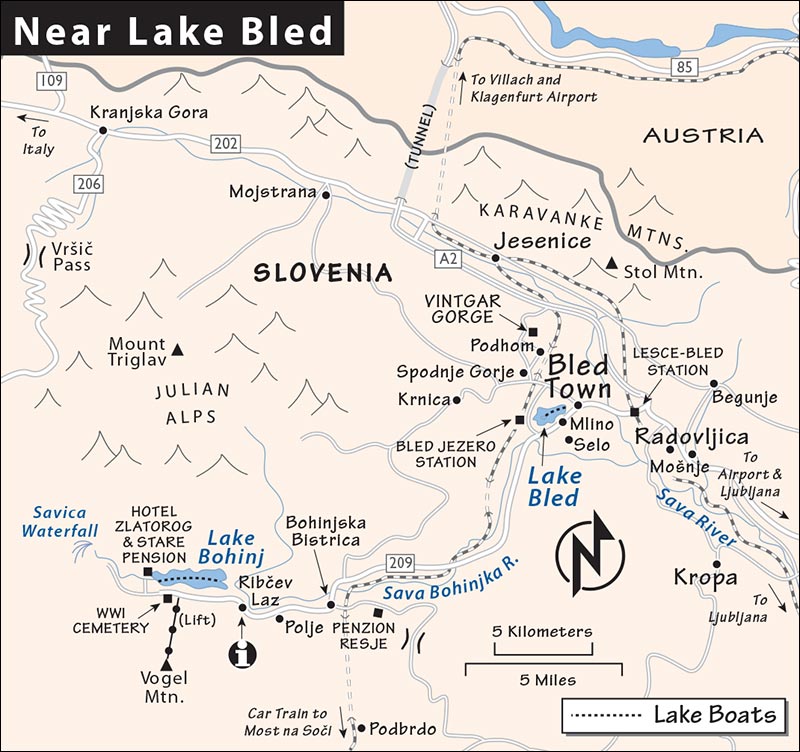
In summer, the easy tourist bus takes you right to the gorge entrance (only runs in the morning; see “Getting Around Lake Bled,” here). Otherwise, you can take a local bus to one of two stops: Podhom (Mon-Fri 5/day in the morning, 1/day Sat, none Sun, 15 minutes) or Spodnje Gorje (take bus in direction of Krnica, hourly, 15 minutes). From either the Podhom or the Spodnje Gorje bus stop, it’s a 15-minute walk to the gorge (follow signs for Vintgar).
Drivers follow signs to Podhom, then Vintgar (see walking/cycling instructions), and park for free right at the gorge entrance.
Gorge Hike: After buying your ticket, you’ll hit the boardwalk trail (sometimes a bit slippery) and crisscross over the most dramatic and narrow stretch, tiptoeing over several waterfalls and marveling at the clarity of the water. Then the gorge—and the trail—flattens out and passes under a high stone footbridge and over a scenic dam. Finally, at the end of the gorge, you’ll reach a footbridge over a plunging waterfall (next to a snack stand and WCs). For more views, continue on five minutes downhill (following the Pod Slap signs), then circle over the river again to reach a knoll where you can peer up at the waterfall and bridge you just crossed.
When finished, you can simply go back the way you came, or take a prettier return to Bled (described next).
Scenic Hike Back to Bled: If you still have energy once you reach the end of the gorge, consider this longer hike back with panoramic views. Behind the snack stand deep in the gorge, find the trail marked Pod Katarina. You’ll go uphill for 25 strenuous minutes (following the red-and-white circles and arrows) before cresting the hill and enjoying beautiful views over Bled town and the region. Continue straight down the road 15 minutes to the typical, narrow old village of Zasip, then walk (about 30 minutes) or take the bus back to Bled.
The town of Radovljica (rah-DOH-vleet-suh, “Radol’ca” for short), perched on a plateau above the Sava River, has the charming Old Town that Bled lacks (refreshingly, it also lacks much of Bled’s summer crowds). The traffic-free core of the town, once hemmed in by a stout wall (still faintly visible in some areas), is jammed with historic buildings that surround the long, skinny main square called Linhartov trg. While Radovljica’s Old Town is a pleasant place to stroll or nurse a coffee, you can see it all in a few minutes. The main reason to visit here is to tour its small but strangely fascinating beekeeping museum—despite having only a few rooms, it still ranks as one of Europe’s biggest on the apiarian arts. Skip the town on Mondays, when the museum is closed (and be aware that the museum has shorter hours off-season).

Tourist Information: The enthusiastic TI loves to help visitors appreciate the town of “Radol’ca” (May-Sept daily 9:00-19:00; Oct-April Mon-Fri 9:00-16:00, Sat-Sun 9:00-18:00; Linhartov trg 1, tel. 04/531-5112, www.radolca.si).
Buses to Radovljica generally leave Bled every half-hour (fewer on weekends, buy ticket from driver, trip takes about 15 minutes). To reach the town center and the bee museum from the bus station, leave the station going straight ahead, cross the bus parking lot and the next street, then turn left down the far street (following brown sign for Staro Mesto). In five minutes, you’ll reach the start of the pedestrianized Linhartov trg (with the TI—on the right—and the start of my “Old Town Stroll”).
Drivers leave Bled on Ljubljanska cesta and follow the directions under “Route Tips for Drivers” on here. The road dead-ends at Radovljica’s pedestrian zone, where you’ll find a parking lot (by the rustic garage), the TI, and the start of my “Old Town Stroll.”
A handy bike path scenically and peacefully connects Bled with Radovljica (about 4 miles, get details at TI).
Whether arriving by bus or by car, you’ll enter the Old Town next to the TI. If you curl around below the main road, you’ll find the scant remains of the city’s original moat—the only surviving one in Slovenia.
On the left, just as you enter the Old Town, Vinoteka Sodček offers a handy opportunity to sample Slovenian wines. Their €12 tasting includes five wines, plus cheese and pršut (air-dried ham)—it’s best to call ahead to arrange this. You can also buy bottles of wine here for €10-15. Owner Aleš knows his stuff (Mon-Sat 9:00-21:00, closed Sun, Linhartov trg 8, tel. 04/531-5071).
Continuing into the Old Town, after a half-block you’ll pass a fun little secondhand shop on the right—crammed with everything from beat-up modern appliances to genuine Slovenian antiques.
Beyond that, the street opens up into Linhartov trg, a charming square fronted by historic buildings. On the left is the Magušarjeva Hiša, a fine old Gothic house where potter Urban Magušar lives, has a studio and exhibition space, and teaches pottery classes—if you’re curious, step into the courtyard and ask him if you can see the house (Trubarjeva 1, mobile 041-734-808).
The Vidičeva Hiša café serves great ice cream and cakes. Farther along is the traditional, recommended Lectar restaurant, with a “living museum” in the basement where you can watch bakers making traditional gingerbread ornaments (€1.50 entry).
Across the street is a monument with a student holding a big medallion image of Josipina Hočevar, a Radovljica native who later helped fund the town’s water system (see the old well nearby) and a school and many important buildings in Krško, near Zagreb. Next to that is the Šivičeva Hiša, an atmospheric late-Gothic house that’s open to the public. If you go a block down any street to the right, you’ll come to a fine valley viewpoint emphasizing Radovljica’s dramatic position on a long promontory.
Dominating the main part of the square is the big, yellow town “castle” (actually a mansion); upstairs you’ll find the Apicultural Museum (described next), the Linhart Museum, and the Baroque Hall—once divided into 10 small offices, but recently restored to its previous grandeur.
Beyond the mansion (and connected to it by a gallery) is St. Peter’s Church; to its right is its rectory, where you can dip into the pretty courtyard.
Circle all the way around the church, then go through the gate to the edge of the ravine. Burrowed into the hillside is a WWII-era bunker left behind by the Nazis. Peeking into the window of the bunker, you’ll see it’s been turned into a chapel dedicated to Edith Stein, a 20th-century Polish Jew who became a Carmelite nun but was arrested by the Nazis and executed at Auschwitz. She was later made a saint by Pope John Paul II (notice the menorah and Star of David inside the chapel, on the right). While she has no official ties to Radovljica, locals are inspired by Edith’s example.
This museum celebrates Slovenia’s long and very proud beekeeping heritage. While the exhibits about the history of beekeeping are oddly fascinating, the highlight is the extensive collection of colorfully painted frontboard panels (used on the front of hives)—one of Slovenia’s most cherished folk arts. Replicas of these panels are sold in souvenir shops nationwide, but these are the real deal.
Cost and Hours: €3, good English descriptions, €1.60 English guidebook is a nice souvenir; May-Oct Tue-Sun 10:00-18:00, closed Mon, shorter hours off-season, Jan-Feb closed Sat-Mon; clean and easy WCs, upstairs at Linhartov trg 1, tel. 04/532-0520, www.muzeji-radovljica.si.
Visiting the Museum: Everything is well-described in English, but this commentary will help you locate the highlights.
The first room of the museum traces the history of beekeeping, from the time when bees were kept in hollowed-out trees to the present day. The bust celebrates beekeeper extraordinaire Anton Janša. On the nearby wall, you’ll see excerpts from his first-ever textbook on beekeeping, as well as documents from other VIBs (very important beekeepers).
In the second room are old-fashioned tools. When a new queen bee is born, the old queen takes half the hive’s bees to a new location. Experienced beekeepers used the long, skinny instrument (a beehive stethoscope) to figure out when the swarm was working up a steady buzz, indicating they were ready to fly the coop. Then, once the bees had moved to a nearby tree, the beekeeper used the big spoons to retrieve the queen—surrounded by an angry ball of her subjects—from her new home before she could get settled in. The beekeeper transferred the furious gang into a man-made hive designed for easier, more sanitary collection of honey. You can also see the tools beekeepers used to create smoke, which makes bees less aggressive. Even today, some of Slovenia’s old-fashioned beekeepers simply light up a cigarette and blow smoke on any bees that get ornery. The life-size model of a man carrying a box on his back illustrates how dedicated beekeepers would trudge uphill with their hives to help them reach higher and higher blossoms as the summer wore on. You’ll also see a variety of old beehives (and a press used to squeeze every last drop of honey out of that comb), as well as photos of apiaries—large, freestanding buildings that house multiple hives. The map on the wall shows how the Carniolan bee—favored by beekeepers for its relatively mellow personality and fast growth in springtime—has been exported far and wide throughout the world, thanks to its adaptability to new climates.
The third room features the museum’s highlight: whimsically painted beehive frontboards (called panjske končnice). Beekeepers, believing these paintings would help the bees find their way home, developed a tradition of decorating their hives with religious, historical, and satirical folk themes. The oldest panel dates from 1758, but the practice really took off in the 19th century. Take your time perusing these delightful illustrations. The depiction of a hunter’s funeral shows all the animals happy...except his dog. In another panel, animals shave the hunter—evoking an old Slovenian saying about “shaving the fool.” Panels also reveal professional stereotypes of the time: One popular panel shows two farmers fighting over a cow, while a lawyer milks it. Another features a giant snail running over very slow-moving tailors (who were considered extremely lethargic in sewing new clothes). Historical panels include a bloody beheading during a local battle and several scenes of troublesome Turks. There’s everything from portraits of Habsburg emperors, to a “true crime” sequence of a man murdering his family as they sleep, to proto-“Lockhorns” cartoons of marital strife, to awkward depictions of foreign lands (based on likely incomplete or faulty descriptions of the day), to 18th-century erotica (one with a woman showing some leg and another with a flip-up, peek-a-boo panel). A few panels blur the line between humorous and misogynistic: Look for the devil sharpening a woman’s tongue on a wheel; the mill where old women are put in and young women are pulled out; or the man carrying a cross—and his wife—on his back. (Equal-opportunity offenders, beekeepers also painted scenes of drunk men being yanked out of bars and away from card games by their wives.) The life-size wooden statues were used to “guard” the beehives—and designed to look like fearsome Ottoman and Napoleonic soldiers.
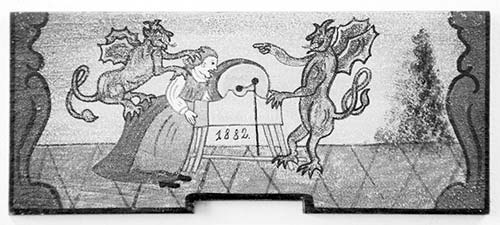
The fourth room examines the biology of bees. In the summer only, look for the actual, functioning beehive. Try to find the queen—she’s usually marked with a dot on her back. The surround-sound hive nearby lets you step inside to hear the noise of a buzzing queen. You’ll also see bee-related products, including wax items, ornaments, and pastries. Another exhibit shows how bees—so respected here in Slovenia, and around the world—are a popular decorative motif, adorning everything from coins to buildings (in many cultures, diligent bees, who store their honey, are symbolic of banks).
The final room features a modern beekeeper’s house, special exhibits, and a good but dry, detailed 14-minute film about the Carniolan bee.
Back at the entrance, the ticket desk sells a few choice souvenirs, including hand-painted replicas of frontboards, honey brandy, candles, ornaments, and other bee products.
Nearby: Sharing a ticket desk with the bee museum, the skippable Linhart Museum celebrates one of Slovenia’s leading Enlightenment thinkers: Radovljica-born Anton Linhart, the 18th-century politician and historian who wrote some of the first plays in the Slovenian language, setting the stage for France Prešeren (€5 combo-ticket with Apicultural Museum, same hours).
Several Radovljica restaurants near the bee museum have view terraces overlooking the surrounding mountains and valleys.
$$$ Lectar offers pricey, hearty Slovenian fare in a rural-feeling setting with a user-friendly, super-traditional menu. Its several heavily-decorated rooms are often filled with tour groups, but in good weather, don’t miss the terrace out back. Come here if you want to linger over rustic Slovenian specialties—not if you’re in a hurry. The restaurant is known for its heart-shaped gingerbread cookies (called lect), inscribed with messages of love. In the cellar is a “living museum” where you can pay a small fee to watch costumed bakers make and decorate these hearts according to the traditional recipe (Wed-Mon 12:00-22:00, closed Tue, family-friendly, Linhartov trg 2, tel. 04/537-4800).
$$ Gostilna Avguštin, across the street, is the simpler local alternative for unpretentious, stick-to-your-ribs Slovenian fare. Their terrace in back enjoys an even better view than Lectar’s (daily 11:00-24:00, Linhartov trg 15, tel. 04/531-4163).
The pristine alpine Lake Bohinj (BOH-heen), 16 miles southwest of Bled, enjoys a quieter scene and (in clear weather) even better vistas of Triglav and the surrounding mountains. This is a real back-to-nature experience, with just a smattering of hotels and campgrounds, rather than the well-oiled resort machine of Bled. Some people adore Bohinj; others are bored by it. While spectacular in clear, sunny weather, it’s disappointing in the clouds (and, because of its position deep in the mountains, it can be socked-in here even when it’s clear in Bled). But if the weather is great and you’re finding Bled too touristy to allow you to really enjoy nature, go to Bohinj.
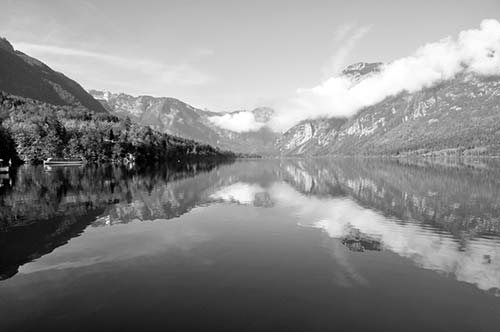
From Bled, hourly buses head for Bohinj, stopping at three different destinations: Bohinj Jezero (the village of Ribčev Laz, 40 minutes), then Bohinj Vogel (a 10-minute walk from the base of the Vogel Mountain cable car, 50 minutes), and finally a few hundred yards more to Bohinj Zlatorog (Hotel Zlatorog and the one-hour hike to the Savica Waterfall trailhead, 50 minutes). In summer, a few buses continue all the way to the Savica Waterfall trailhead (see details under “Savica Waterfall,” later). Off-season, there are fewer buses—confirm times before you depart.
Drivers leave Bled going south along the lakefront road, Cesta Svobode; in the village of Mlino, you’ll peel off from the lake and follow signs to Boh Bistrica (a midsize town near Lake Bohinj). Once in the town of Bohinjska Bistrica, turn right, following Boh Jezero signs. The road takes you to the village of Ribčev Laz and along the lakefront road with all the attractions—the drive from Bled to the lake takes about 30 minutes. You can follow this road all the way to the Vogel cable-car parking lot; at the Vogel turnoff, you can continue straight ahead to reach the Savica Waterfall trailhead, or turn right and cross the bridge to curl around the far end of the lake and see the pristine river that feeds the lake (which flows out of the pool at the base of the Savica Waterfall).
A visit to Bohinj has three parts: a village (offering boat trips on the lake), a cable car (and nearby cemetery), and a waterfall hike. I’ve listed them as you’ll reach them along the main road from Bled, which runs along the south side of the lake. If you plan to do everything (boat trip, cable car, waterfall hike), ask at the TI in Ribčev Laz about a combo-ticket to save some money.
Coming from Bled, your first views of Bohinj will be from the little village called Ribčev Laz (loosely translated as “Good Fishin’ Hole”) at the southeast corner of the lake. Here you’ll find a TI, a handful of hotels and ice-cream stands, and the Bohinj Jezero bus stop.
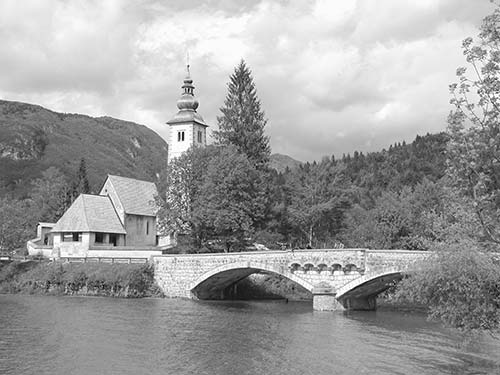
On the way into town, on a small hill to the right, is a monument to the four Bohinj-area mountaineers who first summited Mount Triglav on August 26, 1778.
The town’s main landmark is its picturesque lakefront church, St. John the Baptist (to your right as you face the lake, past the stone bridge; not open to visitors).
A five-minute stroll down the main lakefront road is a dock where you can catch an electric tourist boat to make a silent circuit around the lake (€10.50 round-trip, €7.50 one-way, daily 10:00-18:00, runs hourly, less off-season). The boat stops at the far end of the lake, at Camp Zlatorog—a 10-minute walk from the Vogel cable car (see below).
Across from the Ribčev Laz dock is a fun concrete 3-D model of Triglav. Finally, a few more steps down the road, just beyond a boat rental dock, is a statue of Zlatorog, the “Golden Horn”—a mythical chamois-like creature native to the Julian Alps.
For a mountain perch without the sweat, take the cable car up to the top of Vogel Mountain, offering impressive panoramic views of Mount Triglav and the Julian Alps. On a clear day, this is the best mountain panorama you can get without wings (the light is best in the morning).
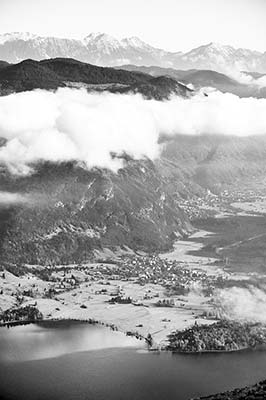
Cost and Hours: €13.50 round-trip, Dec-Oct daily 8:00-18:00, runs every 30 minutes in summer and continuously in winter, closed Nov, www.vogel.si.
Getting There: To reach the cable-car station, drivers follow signs to Vogel (to the left off the main lakefront road, marked 1915 and 1917); by bus, get off at the Bohinj Vogel stop (request this stop from driver) and hike about 10 minutes up the steep road on the left (away from the lake).
Visiting the Summit: After you arrive at the top, savor the views from the metal platform where you exit the cable car...just don’t look down. Walking up through the cable-car station (past the Viharnik snack bar, with basic food and far-from-basic views), you’ll pop out at the summit, a ski-in-winter, hike-in-summer area with a pasture filled with grazing cows and smaller chairlifts to various recreation areas.
The first chairlift is designed for skiers and doesn’t run in summer, but if you hike down into the little valley, you can take the second chairlift up the adjacent summit (Orlove Glave) for views into another valley on the other side. Then, from Orlove Glave, you can hike or ride the chairlift back to where you started. With plenty of time and very strong knees, you could even hike from Orlove Glave all the way back down to Lake Bohinj.
If you need a break near the cable-car station, the alpine hut Merjasec (“Wild Boar”) offers tasty strudel and a wide variety of local brandies (including the notorious “Boar’s Blood”—a concoction of several different flavors guaranteed to get you snorting).
Back down below the cable car, on the main road just beyond the Bohinj Vogel bus stop, look for the metal gate on the left marking the final resting place for some WWI Soča Front soldiers (see sidebar on here). While no fighting occurred here (it was mostly on the other side of these mountains), injured soldiers were brought to a nearby hospital, and those who didn’t recover ended up here. Notice that many of the names are not Slovenian, but Hungarian, Polish, Czech, and so on—a reminder that the entire multiethnic Austro-Hungarian Empire was involved in the fighting. If you’re walking down from the cable-car station, the cemetery makes for a poignant detour on your way to the main road (look for it through the trees).
Up the valley beyond the end of the lake is Bohinj’s final treat, a waterfall called Slap Savica (sah-VEET-seh). Hardy hikers enjoy following the moderate-to-strenuous uphill trail (including 553 stairs) to see the cascade, which dumps into a remarkably pure pool of aquamarine snowmelt.
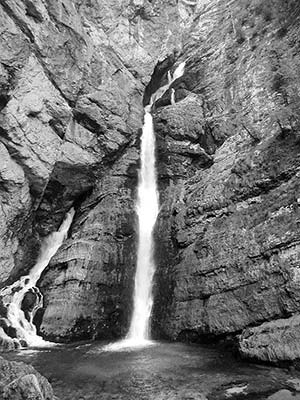
Cost and Hours: €2.50, daily in summer from 8:00 until dusk, allow up to 1.5 hours for the round-trip hike.
Getting There: Drivers follow the lakefront road to where it ends, right at the trailhead. Without a car, getting to the trailhead is a hassle. Boats on the lake, as well as most public buses from Bled, take you only as far as the Bohinj Zlatorog stop—the end of the line, and still a one-hour hike from the trailhead (from the bus stop, follow signs to Slap Savica). However, three buses a day (Mon-Sat July-Sept only, none Sun or off-season) run from Bled all the way to the Savica trailhead (likely departing Bled at 10:00, 14:20, and 16:20, about an hour to the trailhead, returning at 15:30 and 18:30—but confirm times locally before making the trip). Frankly, if the connections don’t fit your itinerary, it’s not worth worrying about.
If you’d like to get away from it all and settle in at Bohinj, consider $ Stare Pension (STAH-reh). Well-run by mild-mannered Jože, it has 10 older, rustic-but-well-maintained rooms (five of them with balconies) in a pristine setting at the far end of the lake (Ukanc 128, mobile 040-558-669, www.impel-bohinj.si, info@impel-bohinj.si). They also rent an eight-person villa for longer stays (info@rent-villa-slovenia.com).
To get higher into the forested hills, you can head for $ Penzion Resje, which sits above Bohinjska Bistrica. Simple but cozy, it has 14 affordable rooms, a great restaurant, and an away-from-it-all local feel, nestled in a tiny village called Nemški rovt—“German road” (Nemški rovt 21A, tel. 04/572-1079, www.penzion-resje.si, resje21a@gmail.com, Jože).